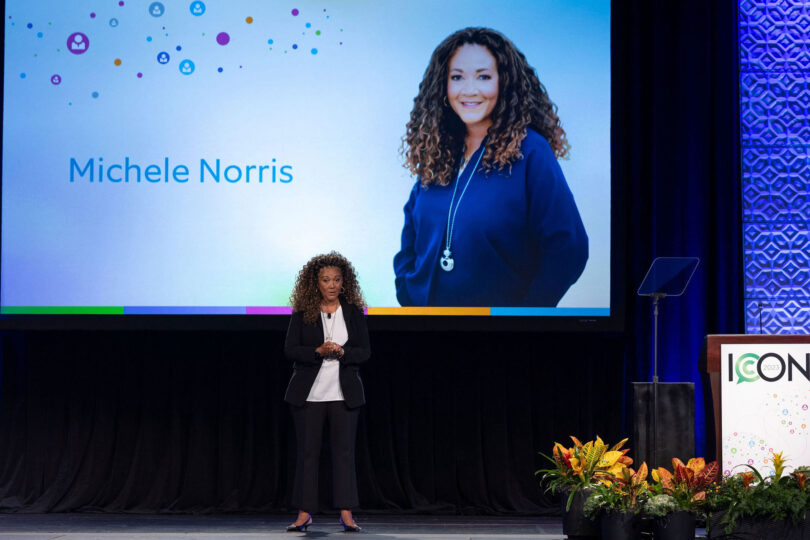As the host of National Public Radio’s “All Things Considered” and a thought-provoking role as a Washington Post Opinions columnist, Michelle Norris has emboldened audiences through candid discussions about race, culture and communication in America.
In August, she debuted her first podcast, “Your Mama’s Kitchen,” which explores how family life and early culinary experiences shape people’s lives. With these conversations (guests have included Michelle Obama, Kerry Washington and José Andrés), Norris opens a window into the connections between food, family, culture and identity.
After her General Session presentation on Oct. 16 at ICON 2023 in Nashville, Tenn., Norris talked with PRSA’s editorial team, Amy Jacques and John Elsasser, about the elements of an engaging story, the art of interviewing and the future of podcasting.
What elements make a story engaging and memorable?
A good story is compelling. It’s surprising. It has twists and turns. It often has a little tension. You go up. You go down. That’s what gives it texture — that arc. Because of all those twists, turns and nonlinear stuff, the story is more interesting.
When crafting a story, what are some common pitfalls to avoid?
Brevity is ever more important, because we’re communicating in sound bites — in little digestible chunks that feel like Cheetos. We’re snacking on stories, as opposed to a buffet. One of the challenges is figuring out how not to lose depth when you’re reaching for brevity.
A pitfall that I try to avoid in telling a story is [thinking that I know] where it’s going to land when I get started. Every story is a journey. I now recognize that I come in with a theory, a loose hypothesis of where I think I might be going. I’ve learned to give myself over to the story and let the story take me where it needs to go. If the story goes over there, that’s where I go.
If I’m interviewing someone and there’s something they mention just in passing, you realize, “Wait a minute — can we go back to that thing you said about your son who’s living in the basement?” The offhand comment that tells a whole story. Sometimes you just have to go with that little flash of light, like a flutter in the edge of your eye. You just follow that. It will take you to interesting places.
In late August, you debuted a podcast called “Your Mama’s Kitchen.” Your guests are naturally gifted storytellers. As an interviewer, how do you manage those conversations?
All of the episodes begin with a variation on the same question: “Tell me about your mama’s kitchen.” And then an interview is a little bit like a great dinner party. You’ve got people around the table, you get the conversation going. You step in when you have to, to keep things going, but you want to make sure that everybody else can tell their story.
In this case, it’s a one-on-one story, so I want to make sure they’re telling the story in their own words, in their own way. I have to get out of the way to do that, and then prompt them: “Can we go back to something you said?”
It’s not really a conversation like you would have with friends, when you’re bantering back and forth. In this case, I am trying to get out of the way and let them tell the story. And if you listen to the episodes, I let them think, also. [They’ll say,] “Wow, I hadn’t thought about that in a long time.”
Matthew Broderick talked about the relationship that he had with the housekeeper in their house, Sally McFall. I realized I just needed to let him talk about that story, what she meant to him and the crazy things that happened in their space. So it’s setting the course for the conversation and getting out of the way, but staying close enough that you can dip in and dip out.
Your podcast is audio-only. Many podcasts these days have a companion video component. Did you think about including video for “Your Mama’s Kitchen”?
When we talked about creating “Your Mama’s Kitchen” and the format, we knew it was going to be a podcast, but a lot of people now are doing podcasts that are augmented by video, and then they go out into social media with a split screen. It’s almost like watching a talk show. I enjoy those a lot.
We decided to stick with audio-only for a couple of reasons. One, it was easier to execute, because we’re talking to people where they are. We’re not always in the same [physical location]. Setting up with the visual element is a lot different.
Also, we were afraid that [adding video to the podcast] would take the guests out of their comfort zones. The idea is, “We want to talk to you about your mama’s kitchen, and you can show up in a pair of pajamas if you want to. You don’t have [to wear] makeup. Nothing fancy. Let’s just talk.” Because the kitchen is such an evocative space, we wanted to tickle people’s imaginations. Sometimes audio-only can do that in a certain way.
In the first episode, that image of Michelle Obama talking about how [her older brother] Craig was really tall and then he became like a walking giant, and how they [notched his height] on the wall — a lot of us had [done something similar in our own homes], but the way she talked about that, about how her dad would put a coin at the top of the door ledge and encourage Craig to jump for that, to work on his height, you’re thinking about her kitchen, but as you’re listening, you’re not distracted by, “That’s really cute, that little jean jacket” she had on that day, because Michelle Obama is always fly.
You’re not distracted by any of that other stuff [that might distract you when watching video]. You’re thinking about Craig reaching up to the top of the door ledge, but you’re probably also thinking about your own kitchen, about the [lines drawn to measure a child’s height] on the doorframe, whether it was in your bedroom, your kitchen or your broom closet. We wanted to create a space of imagination. Sometimes audio-only is a great way to do that.
Here, Norris talks about the future of podcasting:
[Photo credit: jim cowsert/grapevine photo]







